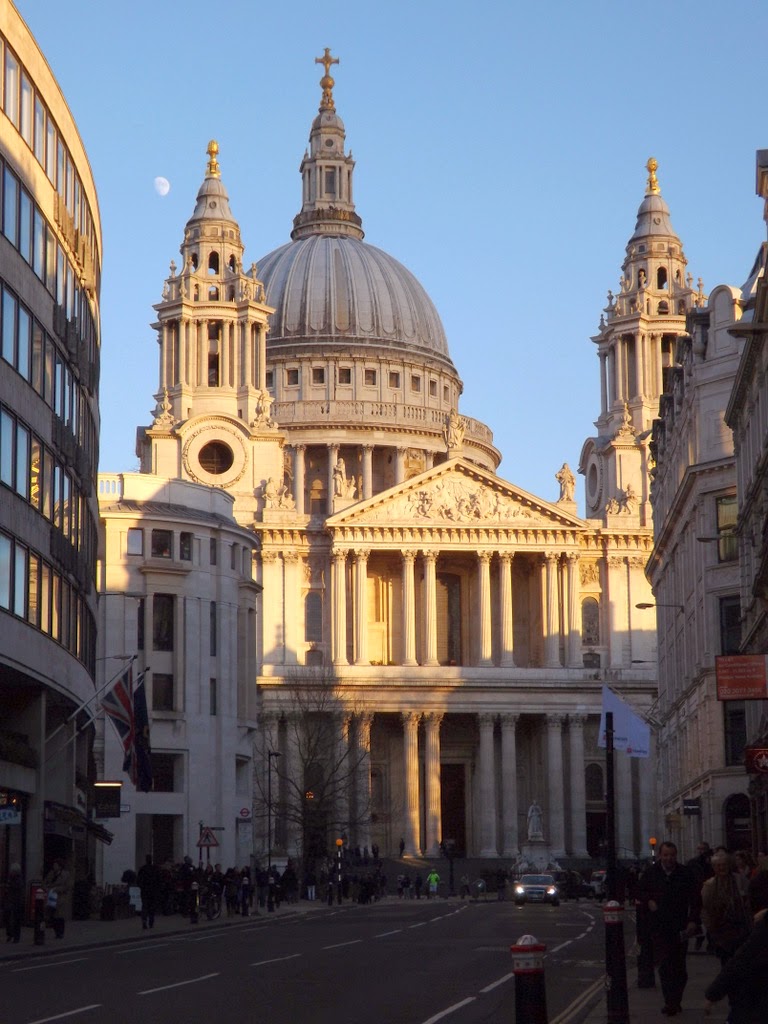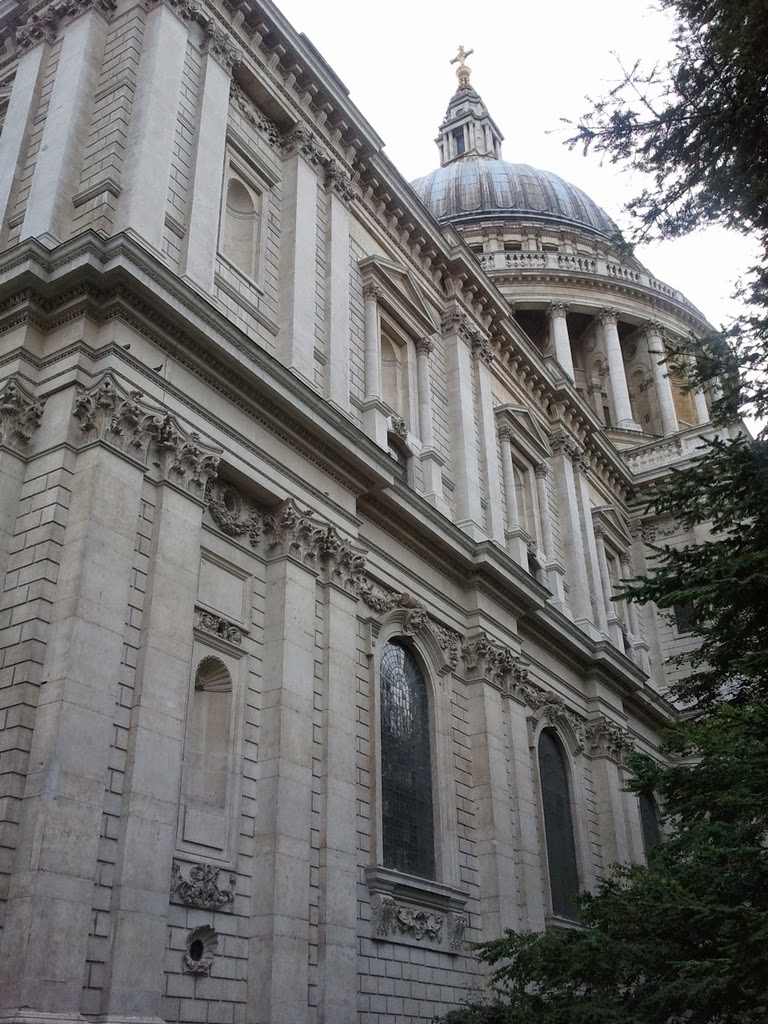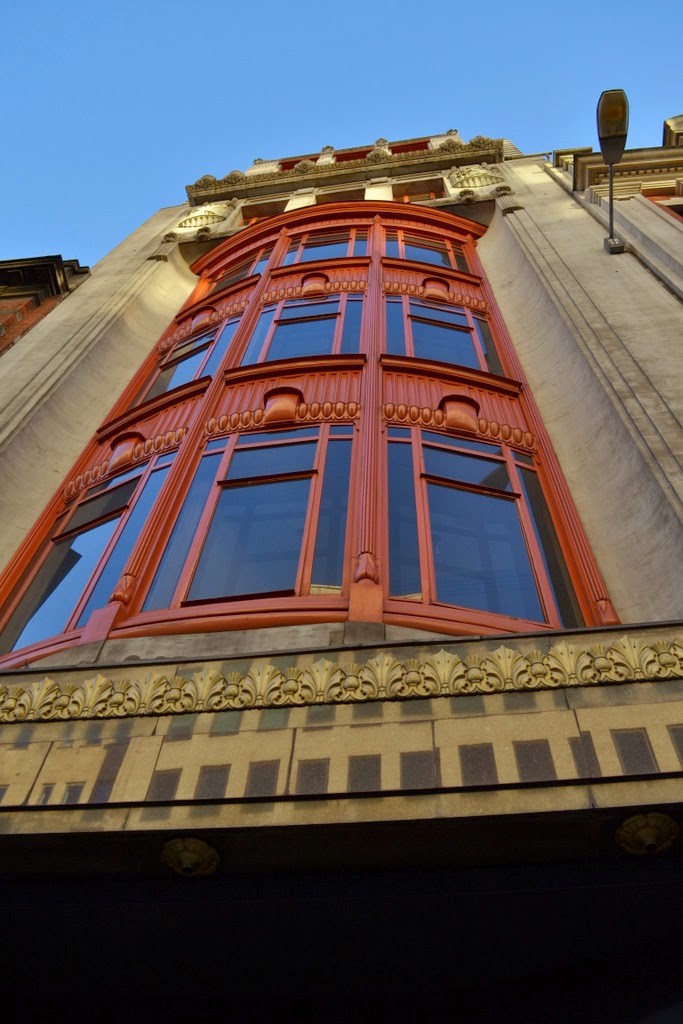We were living for some
months in the UK London Westminster Trafalgar Square Strand then Fleet Street and I saw
that it was an absolutely different area from others that I had known.
Firstly, let's start with Aldwych and The Strand,
which are also special places. Walking next to the huge buildings you can feel
that England
We started our walks on The Strand Underpass. At
the corner of Aldwych is the London School of Economics and Political Science.
The High Comission of India and Australian Centre are also there. The former is
in the Bush House which was the headquarter of BBC until 2012. |
| Bush House |
Rich people had lived in Strand since the 12th Century. It was bishops's and courtiers's residence for centuries. Unfortunately, from the 17th Century, their mansions were demolished and new houses were built in their places.
However, one house looks like an old palace. Somerset House was demolished as well, but was rebuilt in 1775. |
| Entrance from Strand |
 |
| Courtyard |
When Henry VIII died in 1547, his son, Edward VI was too young for the throne. Therefore his ambitious uncle, Edward Seymour proclaimed himself "Lord Protector' and bestowed the title 'Duke of Somerset' himself. Because he believed that the wearer of these titles really deserved a palace, he immediately started to build his own one. He owned this area and demolished some churches and chapels for building materials, which was against the law at that time. Therefore, in 1549, he was imprisoned, but achieved to escape in a short time and continued the construction. In 1551 the palace was completed, but the Prince didn't enjoy it for a long time, because his rivals reached his execution in January 1552 for high treason.
 |
| The terrace of the palace |
The building is currently owned by The Courtauld Institute of Art. There is a great collection of paintings in its museum: Van Gogh, Manet, Monet, Gauguin, Cezanne, Gainsborough, Goya, Tiepolo, Rubens and Botticelli - so next time we will visit it!
 |
| The palace Thames's side |
I think these very ugly figures are male sirens. According to Irish legends they had green hair - it matches after all :-)
I don't know who he might be, but he isn't pretty either... We didn't find anywhere though there are lots of images of the others reliefs. As the others are Roman gods, he is probably Sol, the god of Sun.
The Strand forks two times and both times due to a church. The closer is St Mary le Strand Church, the further is St Clement Danes which is at the end of The Strand.
 |
| St Mary le Strand Chruch and St Clement Danes |
St Clement Danes is the Royal Air Force's church. At the left side of the church is situated one of the wings of The Royal Courts of Justice.
 |
| The Royal Courts of Justice in the background |
Samuel
Johnson's statue stands at the back of the church. According to the
inscription, he was a critic and essayist, philologist, biographer, wit, poet
and moralist, playwright, political writer and speaker. Oh, if I had just one
job from this list... His dictionary played a major role in the development of
modern English language. He was a tall and robust man who was known for his
special gestures and tics. He probably suffered from Tourette syndrome.
There are some not politically correct definitions in his dictionary. For example the meaning of oat: 'a grain which in England is generally given to horses, but Scotland supports the people'. I think he was amused when he guessed the definition of 'dull': 'to make dictionaries is dull work'. Or 'lexicographer': 'A writer of dictionaries, a harmless drudge.'
 |
| Samuel Johnson's statue |
Where the two halves of The
Strand unite again, stands The George pub. Originally, it was a coffee house in
1723, later was transformed to a hotel in 1830 but nowadays it is only a pub.
It is supposedly haunted by a headless knight in its cellar, but he doesn't
hurt anybody. The pub looks as if it would have been built in the 18th Century
but it was only renovated in that style in the late 1890s.
 |
| The George pub is at the left side |
Further down on the right side of The Strand is the Twinings shop. In 1706, Thomas Twinings bought Tom's Coffee House. Soon, he changed it to tea and coffee shop and it has been working since then.
 |
| Twinings shop |
The next house is owned by Lloyds Bank.
 |
| Lloyd's Bank |
 |
As far as they knew, they've hidden the ATM
|
Temple Bar is well seen from here. This is the place where The Strand and Fleet Street meet. It was originally the barrier between Westminster and the City from the late 17th Century until the late 19th Century and it regulated the trade. But it was an important symbol as well: the independence of City. The reigning monarch had to stop here when they wanted to step into the City. Then the mayor offered them the Sword of State (one of the royal insignias) as a token of his loyalty, and granted the freedom to enter to the monarch.
Originally Christopher Wren's arch stood here. It was very narrow so it was moved to Hertfordshire then not too long ago to the neighbourhood of Saint Paul's Cathedral. There is a dragon sculpture in its place.
 |
| Temple Bar |
 |
| The statue of Queen Victoria on Temple Bar |
The building of The
Bank of England was built based on the plans of Sir
John Soane in 1887.
Previously two pubs stood in this place. Most part of the building was
destroyed and rebuilt by Herbert Baker (another famous architect) between 1925
and 1939. According to another famous architect it was the biggest
architectural crime of the 20th Century.
The lease contract of
the bank has expired in 1975. After that, a construction company was hiring it.
Its present tenant is Fuller's Brewery which transformed it to the elegant Old
Bank of  |
| Old Bank of England pub |
 |
| Street view |
Walking further we noticed an interesting sign:
 |
| Sign on the building of Barclays Bank |
But these are squirrels, not goslings :-) The solution is that Twining brothers founded the Goslings Bank in the 'Sign of Ye Three Squirrels' house in 1825. The bank merged with Barclays Bank in 1896.
Ye Old Cock Tavern stands
a few doors down. Originally, its name was 'Ye Cock and Bottle'. It was built
in 1549 and this is the narrowest public house in London 1887.
In addition, a fire destroyed many of the 'original'
decorations in 1990. They were reconstructed on the basis of photographs.
Anyway, it looks old, which is the point.
 |
| Ye Old Cock Tavern |
 |
| St Dunstan in the West Church |
The newspaper publishers have moved away long time ago from Fleet Street, but I somehow still feel how it could have been in the golden age of journalism.
 |
| Dundee Courier's building |
 |
| The formal building of Daily Telegraph on the right |
The name of Fleet
Street was synonymous with journalism. Printers and publishers began to settle
down here around 1500. Their clients were mainly lawyers of the four Inns of
Courts. Then England
I was a bit surprised that I hadn't learned in the university that its publisher was a woman: Elizabeth Mallet. Apparently, a woman having a business wasn't exceptional at that time.
I was a bit surprised that I hadn't learned in the university that its publisher was a woman: Elizabeth Mallet. Apparently, a woman having a business wasn't exceptional at that time.
The Daily Post was
founded by Daniel Defoe in 1719. The Daily Universal Register which is now
known as The Times, was first published in 1785. The Observer, the world's
first Sunday newspaper appeared in 1791. Lots of more newspapers settled here
between 1821-1930: Guardian, Daily Telegraph, Daily Mail, Sunday Mirror, Sunday
Times, The People, Daily Express, Sunday Express, News of the World, Financial
Times, Daily Mirror and Morning Star.
Newspapers and news
agencies obviously attracted actors, artists and intellectuals: they were
guests of many pubs and cafes in the area, including Samuel Johnson, Joshua
Reynolds, William Hogarth, William Wordsworth and John Keats.
At the beginning of the 20th Century publishers had enormous power. They not only reported on the news, but also shaped them (the methods have been refined since then :-)). In the beginning of the 80s, conflicts between journalist, printers and publishers became rife. The former two groups did not want to switch to the new computer based techniques, and their discussions were related to working time as well. In 1986, 6,000 workers went on strike when Rupert Murdoch, the media mogul broke off their negotiations. They did not know that Murdoch had already built up a new printing office in one of the
 |
| St Bride's Church |
Fleet Street ends by Farringdon Street. After the junction it is called Ludgate Hill. From here, you can see St Paul's Cathedral:
 |
| St Paul's Cathedral |
 |
| The old gate of Temple Bar |
Allegedly, there're still some spikes on it, executed heads were stick on there - next time I'll check it. As you are walking below it, you will reach Paternoster Square, one of my favourite places where the old and new are blending very nicely.
 |
| Paternoster Square |
Then we went back to the cathedral, and walked
into its churchyard garden where a tailless squirrel lives. Of course every
tourist gives food for it.
 |
| Churchyard Garden of St Paul's Cathedral |
From here, we cut
through Cannon Street Millennium
Bridge
 |
| Millenium Bridge |
On the other side of the
Thames , in front
of the bridge stands Tate Modern museum. There
is no charge and there are really good, permanent and temporary exhibitions of
modern art in it.
 |
| Tate Modern |
 |
View from one of the terraces of Tate Modern
|
From there you can walk along the bank of the Thames ,
but we'll show that walk in another post. The pictures of this post are based
on several walks. The walking distance - if you do not go into a pub or a
church, just stroll - is at most 2 hours.









No comments:
Post a Comment